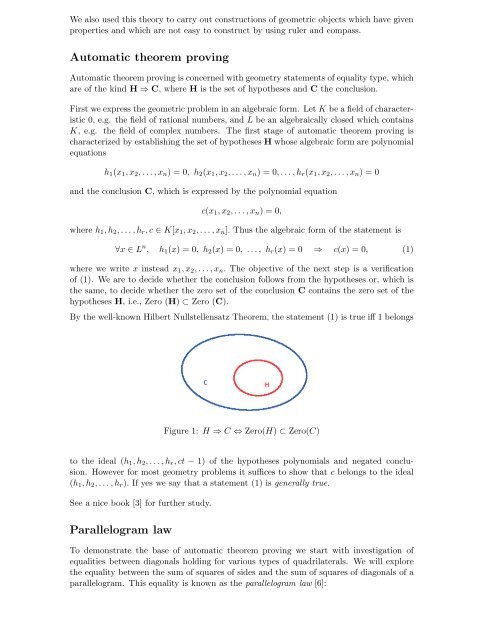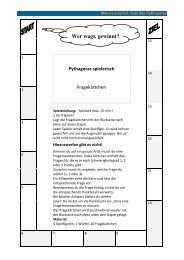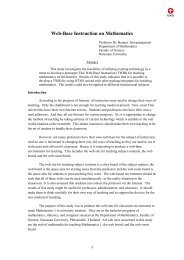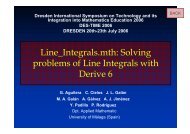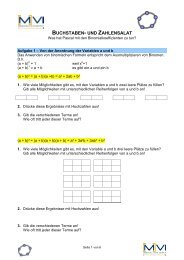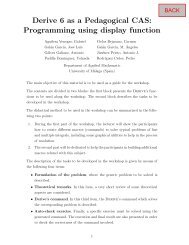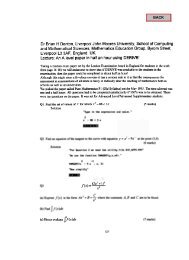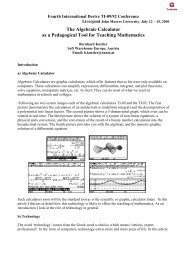Discovering and proving geometric inequalities by CAS (pdf)
Discovering and proving geometric inequalities by CAS (pdf)
Discovering and proving geometric inequalities by CAS (pdf)
You also want an ePaper? Increase the reach of your titles
YUMPU automatically turns print PDFs into web optimized ePapers that Google loves.
We also used this theory to carry out constructions of <strong>geometric</strong> objects which have given<br />
properties <strong>and</strong> which are not easy to construct <strong>by</strong> using ruler <strong>and</strong> compass.<br />
Automatic theorem <strong>proving</strong><br />
Automatic theorem <strong>proving</strong> is concerned with geometry statements of equality type, which<br />
are of the kind H ⇒ C, whereH is the set of hypotheses <strong>and</strong> C the conclusion.<br />
First we express the <strong>geometric</strong> problem in an algebraic form. Let K be a field of characteristic<br />
0, e.g. the field of rational numbers, <strong>and</strong> L be an algebraically closed which contains<br />
K, e.g. the field of complex numbers. The first stage of automatic theorem <strong>proving</strong> is<br />
characterized <strong>by</strong> establishing the set of hypotheses H whose algebraic form are polynomial<br />
equations<br />
h1(x1,x2,...,xn) =0, h2(x1,x2,...,xn) =0,...,hr(x1,x2,...,xn) =0<br />
<strong>and</strong> the conclusion C, which is expressed <strong>by</strong> the polynomial equation<br />
c(x1,x2,...,xn) =0,<br />
where h1,h2,...,hr,c∈ K[x1,x2,...,xn]. Thus the algebraic form of the statement is<br />
∀x ∈ L n , h1(x) =0, h2(x) =0, ..., hr(x) =0 ⇒ c(x) =0, (1)<br />
where we write x instead x1,x2,...,xn. The objective of the next step is a verification<br />
of (1). We are to decide whether the conclusion follows from the hypotheses or, which is<br />
the same, to decide whether the zero set of the conclusion C contains the zero set of the<br />
hypotheses H, i.e., Zero (H) ⊂ Zero (C).<br />
By the well-known Hilbert Nullstellensatz Theorem, the statement (1) is true iff 1 belongs<br />
Figure 1: H ⇒ C ⇔ Zero(H) ⊂ Zero(C)<br />
to the ideal (h1,h2,...,hr,ct − 1) of the hypotheses polynomials <strong>and</strong> negated conclusion.<br />
However for most geometry problems it suffices to show that c belongs to the ideal<br />
(h1,h2,...,hr). If yes we say that a statement (1) is generally true.<br />
See a nice book [3] for further study.<br />
Parallelogram law<br />
To demonstrate the base of automatic theorem <strong>proving</strong> we start with investigation of<br />
equalities between diagonals holding for various types of quadrilaterals. We will explore<br />
the equality between the sum of squares of sides <strong>and</strong> the sum of squares of diagonals of a<br />
parallelogram. This equality is known as the parallelogram law [6]:


